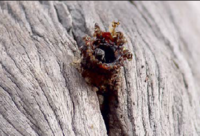| Austroplebeia magna | |
|---|---|

| |
| Worker (top) and drone (bottom) of A. magna. The black arrows point at the characteristic broad basitarsus of the species. | |
| Scientific classification | |
| Domain: | Eukaryota |
| Kingdom: | Animalia |
| Phylum: | Arthropoda |
| Class: | Insecta |
| Order: | Hymenoptera |
| Family: | Apidae |
| Genus: | Austroplebeia |
| Species: | A. magna |
| Binomial name | |
| Austroplebeia magna Dollin, Dollin and Rasmussen, 2015 | |

| |
| Map showing the estimated current distribution of A. cassiae in Australia | |
Austroplebeia magna is a small eusocial stingless bee first described by Dollin, Dollin and Rasmussen in 2015 and it is found in Australia (Northern Northern Territory and far North-West Queensland).
Etymology
The Latin feminine adjective, magna, meaning 'large', refers to a broad section of their legs (Basitarsus III) and long sting lancet in workers of this species.
Description and identification
A. magna is very similar to A. cassiae in size and colouration. The workers (3.5–4.5mm) are darker in colour compared to A. australis. The hind edge of their thorax usually only has two ochre or cream spots. Their face has a thick white hair with at least one full marking hidden underneath it. Sometimes workers have no marking at all on their face or thorax, like some populations found in Arnhem land in the Northern Territory. The males are brightly marked, with cream bands on their face, thorax and legs. The main differences with A. cassiae are their broad basitarsus III, long sting lancet and fine clypeus hair.
Nest building
The nests of A. magna studied so far have been in small to medium size hollow trees (10–24 cm diameter at nest level). The nests have a short nest entrance tunnel. The brood structure and storage pots are similar to the ones in A. australis.
References
- ^ Dollin, Anne E.; Dollin, Leslie J.; Rasmussen, Claus (2015-11-23). "Australian and New Guinean stingless bees of the genus Austroplebeia Moure (Hymenoptera: Apidae)—a revision". Zootaxa. 4047 (1): 1–73. doi:10.11646/zootaxa.4047.1.1. PMID 26624733.
- ^ Dollin, Anne (2016). "Meet the Austroplebeia species -A Guide to Aussie Bee's Revision Paper" (PDF). Aussie Bee. Archived (PDF) from the original on 2016-03-29. Retrieved 21 April 2021.
- Heard, Tim (2016). The Australian native bee book : keeping stingless bee hives for pets, pollination and sugarbag honey. West End, Brisbane, Qld: Sugarbag Bees. ISBN 978-0-646-93997-1. OCLC 910915206.
| Taxon identifiers | |
|---|---|
| Austroplebeia magna | |


